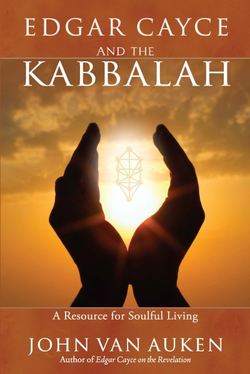Читать книгу Edgar Cayce and the Kabbalah - John Van Auken - Страница 23
На сайте Литреса книга снята с продажи.
Changing the Name of God
ОглавлениеLet’s conclude by reviewing stages of our Creation as expressed by changes in the name for God.
The Scriptures begin, breshit bara elohim [there is no distinction between lowercased and uppercased letters in Hebrew], “In the beginning God . . . ” The first name for God, as seen is this first line of Genesis, is Elohim. It is a plural Hebrew word that may be interpreted as “the Deities,” and the verse about creating us is translated in the plural as well : “Let us make man in our image, after our likeness.” (Genesis 1:26; emphasis mine) By using the plural form, the authors were likely attempting to convey the collective nature of the Creator, to keep us from thinking that God is a divine individual, projecting individuals in its image, and that God is in some way a separate Being from us. Rather, it is a collective consciousness within which all the Creation was conceived and in which all exists. Elohim may be likened to the great assembly spoken of in Psalm 82:1, indicating all exists within this collective: “God is in the assembly of God; he is judging among the gods.” Curiously, though, when this plural name is used, it is commonly construed with singular verbs and adjectives, adding to the belief that this is not polytheism but the collective nature of God. Before we leave this psalm, consider verse 6: “I said, ‘You are gods, all of you are sons [and daughters] of the Most High.’” This is clearly a reference to our highest level of being, the Spirit Being with the Spirit Mind.
Kabbalah uses another name for the highest of God’s qualities, a name that does not appear in any Scripture. It is Ein Sof, which relates more to God beyond the Creation. This is God transcendent (ad le-ein sof). Gershom Scholem (December 5, 1897 to February 21, 1982), widely regarded as the founder of the modern, academic study of Kabbalah and the first professor of Jewish Mysticism at the Hebrew University of Jerusalem, taught that Ein Sof is the emanator of the emanations (sefirot). Sefirot are God’s energy and consciousness emanating throughout creation and found in the Kabbalah Tree of Life, which we will study in a later chapter.
Let’s continue with God, ourselves, and the evolving changes in the name of God.
As the Creation progresses, the name of God is changed. Changing the name of the God reflects changes in our relationship to God, not God’s changing condition. God is unchanged. Originally, we were created in God’s image, in Elohim’s image. (Genesis 1:26) Then, in chapter two, Yahweh Elohim (often interpreted as “Lord God”) creates us out of the dust of the earth and breathes life into us. (Genesis 2:7) In chapter four, Yahweh (Lord) is used during and after the birth of Cain and Abel. As the Bible story continues, God is called Adonai (Master), El (Mighty One), El ‘Elyon (Most High God), El Shaddai (God Almighty), El ‘Olam (Everlasting God), El Hai (Living God), and Avinu (“Our Father,” as found in Isaiah 63:16; Jeremiah 31:9; Psalms 103:13; and 1 Chronicles 29:10). In the New Testament, Jesus continues the Jewish concept of God as Father, using Abba (“Father” in Aramaic and in colloquial Hebrew at the time of Jesus).
All of these names reveal our shifting relationship with God as we grow away or toward oneness with our Creator. Consider how God identified Him-Herself to Moses on the mount when answering Moses’s question about His name: “I am that I am.”
And Moses said unto God, “Behold, when I come unto the children of Israel, and shall say unto them, the God of your fathers hath sent me unto you; and they shall say to me, What is his name? What shall I say unto them?” And God said unto Moses, “I AM THAT I AM”; and he said, “Thus shalt thou say unto the children of Israel, I AM hath sent me unto you.”
Exodus 3:13–14
We may read this as indicating that the collective cannot possibly be separate from the Creation; therefore, the sense of self that we feel in our expression “I am” is a portion of the Great I AM in whose image all of the little “I am’s” were created and exist. Edgar Cayce expressed it this way: “This is that portion of the lesson as is to be grounded into the inmost Self until all come to know that not only God is God but the self is a portion of that Oneness.” (EC 900–181)
